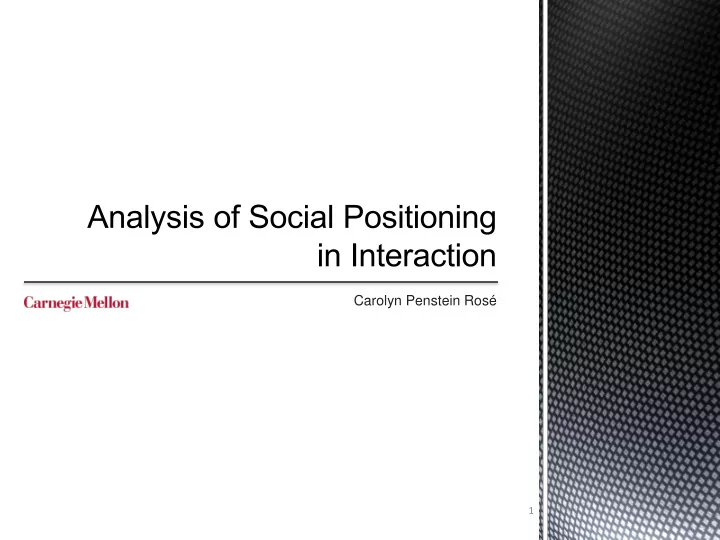

Carolyn Penstein Rosé 1
• Theoretical framework • Psychology-> Sociolinguistics -> Language Technologies • Authoritativeness: Vertical power distance • Results using Integer Linear Programming • Transactivity: Horizontal power distance • Results using Support Vector Machines and Dynamic Bayesian Networks • Applications in Learning Technologies and Health Informatics 2
• Basic concepts of power and social distance explain social processes operating in interactions Language Technologies • Social processes are reflected through patterns of language Sociolinguistics variation • If we understand this connection, Psychology we can model language more effectively • Models that embody these structures will be able to predict social processes from interaction data 3
• Some influential theories • Social Identity Theory Authority (Brewer, 1997) • Self-Categorization Vertical Theory (Turner, 1985) Social • Social Cognitive Theory Distance (Bandura, 1986) Person Identity • We gain influence in Horizontal Social interaction through Distance manipulation of horizontal and vertical social distance • We manipulate distance through signaling 4
K2 requesting information, knowledge, opinions, or facts A2 K1 Instructing, suggesting, or giving opinions, knowledge, requesting non-verbal action information, or facts A1 Narrating or performing your own non-verbal action Additionally… Authoritativeness: ch (direct challenge to previous utterance) # Source Core Moves o (all other moves, backchannels, etc.) # Core Moves 5
Constraints for Integer Linear Programming… (Martin and Rose, 2003) 1. You don’t request information or action after it’s been given. 2. Knowledge and action don’t mix. 3. You don’t respond to the same request twice. 4. You don’t respond to your own requests. 6
Machine Learning for Negotiation Data: 20 hand-coded conversations (4374 turns) Results given are from 20-fold leave-one- conversation-out cross validation All improvements between models are significant (p < .01) Tools used: • SIDE (Mayfield and Rosé, 2010) for feature extraction • SVM light (Joachims, 1999) for machine learning • Learning-Based Java (Rizzolo and Roth, 2010) for ILP inference 7
0.95 Authoritativeness r^2 0.68 Accuracy 0.58 Kappa 0 0.1 0.2 0.3 0.4 0.5 0.6 0.7 0.8 0.9 1 Baseline Baseline+ILP Contextual Contextual+ILP Human (Upper Bound) 8
Is Authority useful? Yes! (joint work with Iris Howley, CSCL 2011) In pairs, ratio between students’ Authoritativeness ratios predicted group self-efficacy. More authoritative students also showed more warning signs of aggressive (“bullying”) behavior. In MapTask data, groups with more authoritative instruction givers produce more errors. 9
• Explicitly display [Student1] Well…. U do know that increasing tmax reasoning and pmax means more Qin • Orient contributions [Student2] yeah, that towards previous makes an argument for not using that idea in our contributions design – but on the other side, it leads to more quality – which means you get more work out of the turbine 10
Evaluating Context-Based Features 0.80 0.73 0.73 0.75 0.71 0.70 0.69 Kappa from 10-fold CV 0.67 0.70 0.66 Features 0.65 0.62 0.61 0.61 unigram, bigram, length 0.61 depth, parent_child_similarity 0.60 fsm 0.55 0.52 0.50 Base + Thread 0.45 0.40 Social Macro Micro Baseline Dimension Base Base+Thread Base+Seq Base+AllContext
• Modeling speech style accommodation using dynamic Bayesian networks (Jain et al., submitted) R 2 = 0.18 • Leveraging the idea that social processes are continuous rather than instantaneous • Correlating speech style accommodation with transactivity (G weon et al., submitted) 12
• Both transactivity and authoritativeness correlate with learning • Applications in online assessment of group learning • Triggering context sensitive support for group learning • Recent demonstration of generalization to doctor-patient interactions • Authoritativeness predicts some important patient perception metrics • Automatic analysis may support doctor professional development 13
Thank You! Questions? 14
Do you have a K2 Yeah. K1 camera shop? Okay, first go down A2 K2 How far down do I go? along the left hand side of that. All the way down to the bottom left corner. K1 A1 Right. Right. o 15
Now go up to the left Where’s that? A2 K2 of the youth hostel. Right above the I don’t have that. K1 ch alpine garden. 16
Recommend
More recommend